Cave un-roofing as a large-scale geomorphic process
Klimchouk Alexander
Abstract: A morphogenetic approach appears to be the most sensible in defining the tiankeng as a typological category. Tiankengs are giant collapse dolines formed over large river caves, with continuous precipitous perimeter and a diameter-to-depth ratio between 0.5 and 2. The term bears an evolutionary meaning, referring to the youthful stage of open collapse doline development, and the relationship of tiankengs to large underground rivers. The latter criterion separates tiankengs from other types of giant collapse features, such as caprock collapses over evaporates or large collapses over hydrothermal cavities. The South China karst offers evidence that un-roofing of caves is a large-scale geomorphic process playing an important role in the formation of cone and tower karst. It is probably the major process in the origin of large depressions, gorges and valleys in tropical karst, although other geomorphic processes contribute to shaping and maturation of a landscape and eventually obscure the origin in unroofed caves. Many saddles between hills and towers in fengcong and fenglin karst may owe their origin to cave un-roofing.
Keywords: morphogenetic, approach, tiankeng, typology, category, collapse, dolines, river caves, cave, precipitous, diameter-to-depth, underground river, collapse, caprock, evaporates, hydrothermal, cavities, South China, china, karst, un-roofing, geomorphic, cone, depressions, gorges, valleys, tropical karst, maturation, landscape, unroofed caves, saddles, fengcong, fenglin
Introduction
An extensive field excursion in the South China karst, for Chinese and international karst scientists within the Tiankeng Investigation Project during October 2005, had the objective of evaluating the validity of the tiankeng term as a distinctive typological category of giant dolines. The fieldwork also provided an excellent opportunity to appreciate fengcong and fenglin karst. Based on observations made during the excursion, this paper first discusses how the typological distinction of tiankeng may better be established, and then discusses the role of cave un-roofing in the formation of tropical karst.
The tiankeng as a typological category
Alternative methodological approaches may be used to define tiankeng as a typological category of karst geomorphology. These are considered with reference to the characterization of tiankengs in China provided by Zhu & Chen (this volume).
Morphological approach
A morphological approach uses characteristics of shape and dimensions as principal criteria for delineating tiankengs as a type. Genetic considerations are subordinate, used only to distinguish between sub-types of tiankengs. Chinese researchers have generally followed this approach. They have stressed morphological and morphometric criteria in delineating a tiankeng as a type of giant doline, and have distinguished collapse tiankengs and erosional tiankengs as sub-types.
The principal morphological and morphometrical characteristics of tiankengs are:
- Vertical or sub-vertical walls, giving a pit-like profile;
- Large diameter and depth (the minimum limit is arbitrarily set at 100 m for both dimensions);
- Continuous precipitous perimeter;
- Small diameter/depth ratio (generally between 0.5 and 2).
The use of morphological criteria alone does not seem to be adequate to define a tiankeng as a typological category within karst geomorphology, as this would lead to the blending of features of different origins.
Genetic approach
A genetic approach stresses the origin and development of the features, and the processes and conditions essential for them to form. Morphological considerations remain relevant, as they are used to broadly delineate a family of forms to assess. However, morphological criteria within this approach are not decisive, but are subordinate to genetic considerations. As geomorphological features evolve and change through time, the genetic approach should account for evolutionary changes and variations in the morphology
The studies by Chinese workers (and observations during the 2005 fieldwork) strongly suggest that most tiankengs are collapse features that have formed over large underground river passages. They form where some favourable speleogenetic conditions (sites of lateral and/or vertical expansion of a river passage) coincide with geological weaknesses (structural or lithological disruptions). The formation of tiankengs may involve various breakdown mechanisms and processes (including upward stoping by slab and block breakdown, lateral expansion of an initial opening through face retreat, and un-roofing of a cavity by subaerial weathering).
The established Chinese usage of the tiankeng term implies vertical and sub-vertical walls as an attribute of this feature, but the genetic approach requires a feature to be viewed in the evolutionary perspective. For most collapse dolines, vertical or steep walls characterise the youthful stage. Their evolution, through maturation to degradation, involves the smoothing of profiles, increasing the diameter, and decreasing the depth, hence increasing the diameter/depth ratio (Fig.1). A roughly circular perimeter, that is initially continuously precipitous, is breached on one or more sides, commonly along large cave passages or surface gulleys intercepted by the collapse (Fig. 2). A study of radar topography models (SRTM) of the South China karst (Fig.3) suggests that fengcong topography is characterized by the presence of numerous giant dolines, including those with gentle slopes and breached sides, most of which can be regarded as degraded tiankengs if the term is defined under a genetic approach.
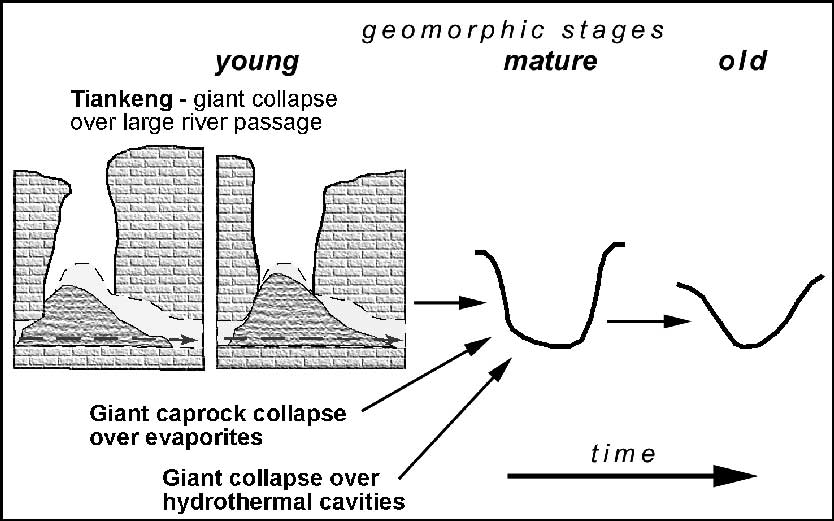
Fig. 1. The place of a tiankeng within the morphogenetic typology of giant collapse dolines.
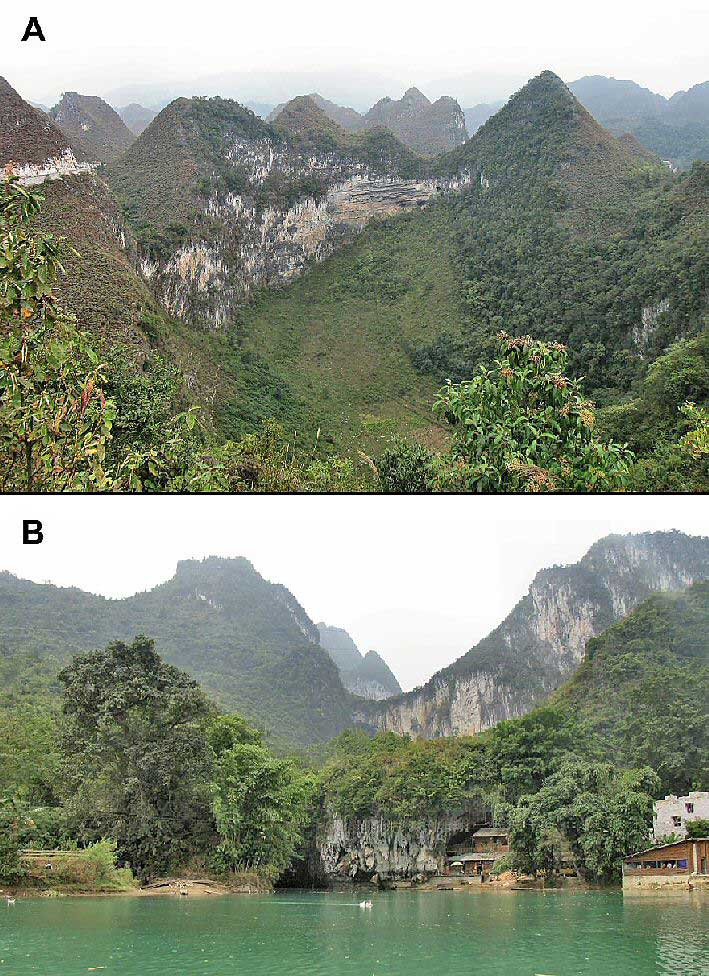
Fig. 2. Degrading collapse dolines. Degradation is by destruction of cliffs and accumulation of colluvium, and by breaching of the perimeter due to progressive un-roofing of connecting cave passages or surface fluvial processes. A: a degrading tiankeng in the Leye karst, Guangxi. B: degraded collapse dolines (karst windows) aligned to the course of a low-gradient underground river at Sanmenhai Dong, Guangxi; the area between the cliffs in the foreground and the middle-ground is occupied by two collapses that expose fragments of the cave river; further cave un-roofing and merging of collapses will create a valley.
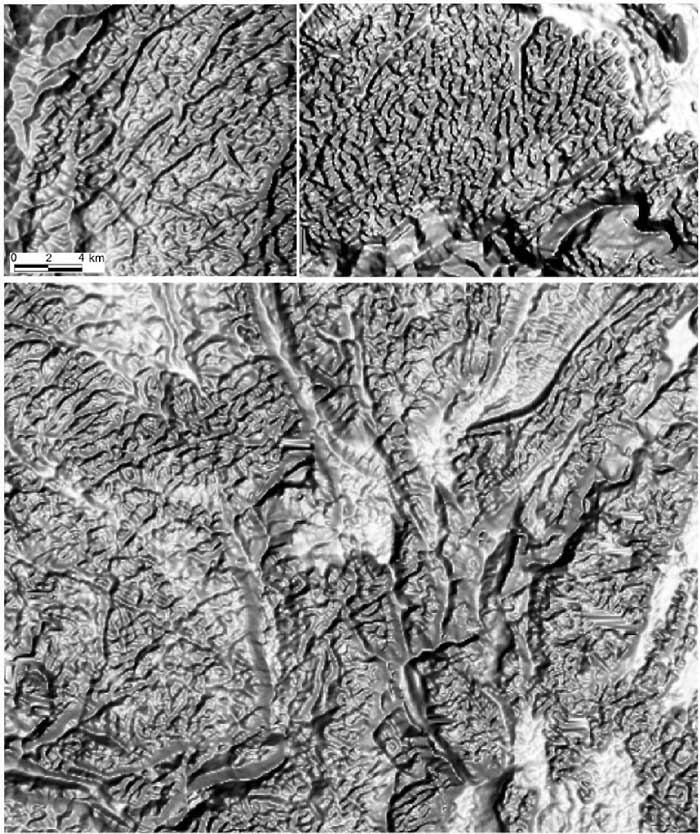
Fig. 3. Samples of typical fengcong karst areas in South China, represented by digital topography models based on SRTM data. Giant dolines of the tiankeng scale are numerous, constituting a notable component of the landscape. Many of them, although smoothed to a degree, still retain their distinctive closed perimeters, and are so isolated in the topography that their collapse origins are apparent. Other dolines have merged to create valleys, or have broken at their sides to create amphitheatres onto adjacent lowland. Collapse and un-roofing forms, re-worked to a variable degree, reveal patterns that may best be interpreted in terms of disintegration of the structurally guided underground karst.
The simple genetic approach does not allow inclusion of large erosional features (the erosional tiankengs of Chinese workers) to the tiankeng category. These are a kind of karst shaft with abnormally large diameter, formed mainly by dissolutional and erosional action of sinking streams (commonly of allogenic drainage). The presence of a large underground river and its trunk cave passage is not a prerequisite for erosional shafts to form. Hence, their origin is radically different from common tiankengs, which are principally collapse features.
Morphogenetic approach
A morphogenetic approach to defining tiankengs considers equally the genetic and morphological criteria and views them in relation to each other.
Tiankengs are defined as giant collapse dolines (the minimum limit is arbitrary set at 100m for both depth and width) formed over large river passages (chambers), which have continuous precipitous perimeter walls and a diameter-to-depth ratio ranging between 0.5 and 2. The morphological characteristics used in the definition are inherent to young collapse dolines. Therefore the term "tiankeng" bears an evolutionary meaning, referring to the youthful stage of open collapse doline development (Fig. 1).
This approach allows establishing tiankengs as an evolutionary subtype (stage) of giant collapse dolines (mega-dolines). Further geomorphic evolution of tiankengs leads to their degradation, so that older forms loose the distinctive morphological characteristics of tiankengs and should better be generically termed as giant collapse dolines.
Within the morphogenetic approach, two characteristics of tiankengs are of primary importance:
1. Gigantism of tiankengs. Tiankengs are giant collapse dolines. Setting up the lower limit for depth and diameter is arbitrary but necessary, as it is gigantism that relates tiankengs to specific conditions of formation and separates them from other types of collapse dolines.
2. Relation to large underground rivers. Tiankengs are collapse features formed over large underground river passages. This characteristic is linked with gigantism and refers to the specific mechanisms of creating a large underground void that can serve as a receptacle for a large mass of breakdown material. Moreover, dissolutional removal of material by an underground river is an important factor for massive breakdown development, the upward propagation of the breakdown structure and its eventual opening to the ground surface.
Both the gigantism and the large underground rivers tie tiankengs to humid tropical environments or to situations in other climates where allogenic streams are swallowed into karst to produce large underground river passages. The genetic criterion separates tiankengs from other giant collapse features, including caprock collapses over evaporates (e.g. in Canada and Russia) and large collapses over hydrothermal cavities in arid regions formed (e.g. in Oman), which do not classify as tiankengs.
Limestone gorges
Gorges with vertical walls, or slot canyons, are common landforms in many limestone karst areas. Although their formation at some sites has been attributed to cave roof collapse, due to the presence of obvious remnants of cave morphological features, karst geomorphologists generally tend to avoid recognizing this mechanism as being of primary importance in gorge development. Instead, the primary process behind vertically walled gorges is believed to be surface fluvial entrenchment; the gorge walls do not flare out to valley slopes because their degradation is limited by infiltration and reduced runoff (Jennings, 1971).
During the 2005 Tiankeng Investigation Project, two remarkable limestone gorges were observed in the Chongqing karst, and both offered unambiguous evidence of the formation due to roof collapse of major cave river passages. The evidence included the presence of fragments of former cave roofs surviving as natural bridges in the otherwise open sections of the gorges, and abrupt terminations in front of major trunk cave passages at upstream and/or downstream ends of the gorges.
The Sanqiao (Three Bridges) site is a perfect example of gorge formation by cave un-roofing (Fig.4A). It has several closely spaced tiankengs aligned on the course of a river that was formerly subterranean. The tiankengs are separated by massive natural bridges, that are remnants of the trunk cave passage. Evolution of the tiankengs continues by their elongation along the river, which will eventually breach the bridges and merge the tiankengs (Fig.4, C-D).
Tianjing Gorge (also know as the Great Crack, Fig. 4B) has its downstream end continuing into a trunk cave passage through to the Xiaozhai Tiankeng. Within the gorge, a remnant bridge illustrates the mechanism of roof retreat, by which the gorge continues to extend. Limestone in the face of the bridge is exposed to weathering at the end of the gorge, so that the remnant of cave roof retreats while the gorge advances along the passage (Fig. 5A). Where the roof thickness above major cave passages is not too great, such lateral roof cutting is probably the main mechanism of cave un-roofing and gorge propagation, after collapses at the weakest sections have established initial openings (tiankengs). The process of face weathering includes dissolution, erosion, crumbling, slab and block breakdown. The same situation was observed on one of the bridges in the Sanqiao site (Fig. 5B).
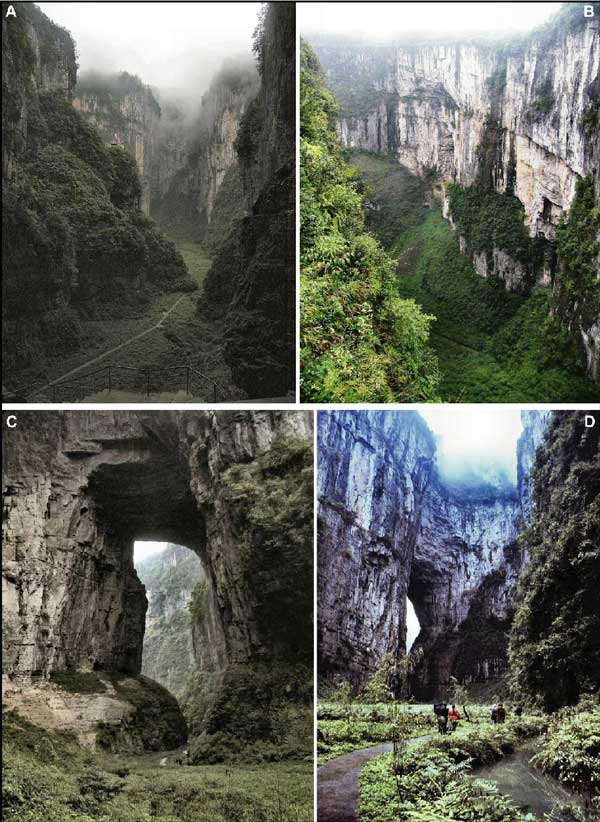
Fig. 4. Limestone gorges formed by un-roofing of trunk cave river passages. A : Sanqiao (Three Bridges). B: Tianjing Gorge (Great Crack). C and D: karst bridges, the remnants of the cave roof, separating open sections of gorge at Sanqiao.
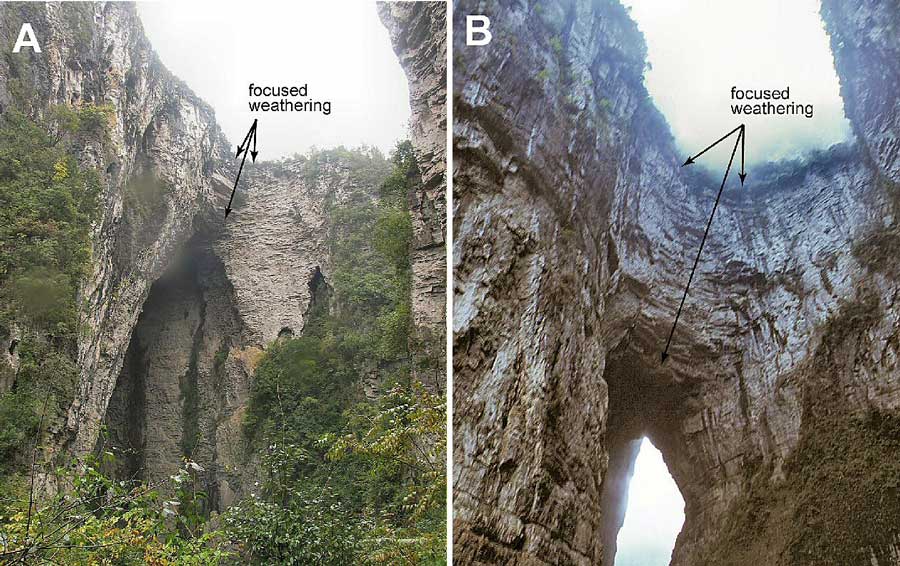
Fig. 5. Focused weathering at the terminations of gorges that continue into cave passages. A: within the Tianjing Gorge. B: within the Sanqiao site.
These examples strongly support the contention that gorges have been formed due to un-roofing of caves, and that tiankengs were precursors to the gorge formation. The un-roofing starts by a collapse and continues through lateral roof retreat. Further massive collapses along the course of a trunk passage are certainly possible, progressively fragmenting the cave and creating more fronts for lateral retreat.
Un-roofing of caves
During the last decade considerable attention has been given by many researchers to so-called unroofed (denuded) caves. It was long ago appreciated that lowering of the karst surface due to ongoing denudation inevitably results in uncovering and destruction of caves, but recent works in Slovenia drew specific attention to unroofed caves (Mihevc, 1996; Mihevc et al, 1998). Unroofed caves are recognized as particular surface karst forms, partially transformed by surface processes. However, the wider role of cave un-roofing within karst geomorphology is not yet clarified. Broadly speaking, karst collapses, including tiankengs, are variants of cave un-roofing, as is the formation of limestone gorges through collapse and lateral roof retreat.
The role of cave un-roofing in tropical karst
Within the Guangxi karst, an area of typical fengcong stands above a common bedrock base, which rises from a corrosion plain at base-level (Fig. 6). A river flows from the plain into a trunk cave passage that is progressively losing its roof. The cave un-roofing, and the localised retreat of the limestone hill is one of the geomorphic processes that cuts the massif to base level. Other cave passages, when unroofed, create lows in the denuding fengcong topography. It is likely that the gentle valley above the cave entrance had been formed by un-roofing of a trunk passage within the ancient high-level of the same multi-phase cave system. It is equally likely that un-roofing of other, older passages of this paleo-cave system contributed to the formation of the present landscape now seen as a typical fengcong karst. It is suggested that cave un-roofing plays a major role in the formation of tropical karst.
Cone and tower karst landscapes (fengcong and fenglin) are essentially residual karst morphologies, resulting from long-lasting intense karstification in humid tropical conditions. The formation of these landscapes has been viewed mainly from the perspective of surface geomorphic processes. It is commonly accepted that preferential near-surface dissolution is the primary mechanism involved, with surface collapse playing only a minor role (Day, 2004). The cones and towers are considered as erosional remnants, while the intervening depressions and lowlands are the focus of current karstic dissolution and fluvial geomorphic activity.
The morphology of cone and tower karst is extremely variable. One of the main causes of this variability is a diversity of regional tectonic evolution and base-level history. Tectonic uplift and base-level lowering cause rejuvenation of mature landscapes, and the re-organisation and complication of their geomorphic systems; in the case of karst, this extends to both surface and underground components. In karst, rejuvenation underground is a prerequisite for rejuvenation of the surface topography (Ford & Williams, 1989: p438). Multiple phases of uplift and base-level shifts, alternating with prolonged periods of stability, may add considerable complexity to the geomorphic system (Ford and Williams, 1989: Fig. 9.34).
Collapse features are indicators of rejuvenation of karst landscape. Tiankengs are fresh landforms, in which the collapse origin is readily recognizable. The same applies to gorges which have remnants of cave roof (bridges) or which are directly continued by cave passages. In mature landscapes, such as typical fengcong karst, the collapse origin of the forms is not so obvious from their morphology, and it can be only inferred from oblique evidence.
There are several lines of evidence that support the important role of cave un-roofing in the formation of fengcong and fenglin karst terrains:
- Un-roofing of caves is an inevitable consequence of ultimate karst development. Any void in the rock will be unroofed in the course of karst denudation. When unroofed, elements of cave morphology integrate into the surface topography. Caves are therefore precursors of negative landforms in the future topography.
- Dimensions of cave passages in tropical cone karst are great enough to play an important role in surface karst topography when caves are unroofed. This is directly evidenced by tiankengs and gorges, which are freshly unroofed caves (Fig.4). Numerous cave remnants in mature tropical karst suggest that dimensions of the caves are comparable with those of major elements of the cone karst morphology (Fig. 7). Cave explorations made during last two decades, by the China Cave Project and many other groups, suggest that typical dimensions of trunk passages are many tens of metres in width and height but in many places they exceed 100 metres.
- The number of cave passages in tropical cone karst is great enough to play an important role in surface karst topography when underground systems are denuded. The potential of this may be inferred from the 2800 underground rivers, with a total length estimated at about 14,000 km, within the 150,000 km2 of cone karst in South China (Zhu & Chen, this volume). The total length of substantial passages in cave systems (including abandoned passages in upper levels) should be at least several times greater. This suggests that elements of cave morphology will inevitably constitute important and common elements of surface topography when integrated into cone karst landscapes.
- There are many caves remnants, including karst bridges and arches, truncated passages and unroofed cave gorges, that are incorporated into modern karst landscapes, many of which are mature.
- Recognition of the role of cave un-roofing in the formation of cone karst morphology is impeded by the problems of interpretation of mature landscapes, in which unroofed remnants of cave passages are so greatly reworked by surface processes that their origins are obscured.
In most karst terrains, the depressions and lowlands between the cones and towers are mainly interpreted as being formed by focused karstic dissolution and fluvial geomorphic activity. In the light of the above arguments, an alternative interpretation is that a considerable proportion of them have originated due to the un-roofing of caves.
Depressions
Bearing in mind the proven collapse origin of tiankengs and their geomorphic evolution by degradation), many, if not most, large dolines recognizable in fengcong karst could be interpreted as degraded tiankengs. Digital topography models of sample mature fengcong karst terrains in Guangxi reveal numerous large depressions and blind valleys, which could have evolved from tiankengs (Fig. 3). The interpretation that most large depressions in mature fengcong karst are degraded tiankengs (or otherwise originated as collapse features) is also supported by some observed densities of normal tiankengs in areas experiencing rejuvenation; in the Leye karst of Guangxi, the Dashiwei group consists of 26 tiankengs. This indicates that surface collapse could be the prime origin of large depressions in other fengcong karst areas that have evolved into mature karst landscapes.
Saddles between cones
Integral features of the fengcong karst are saddles (or passes) between adjacent cones (Fig.6). Although research specifically addressing their nature appears to be unpublished, they are tacitly understood, within the conventional geomorphological thinking, as being the result of some sort of surface fluvial activity, perhaps relicts of a fluvial paleo-drainage pattern, or of selective denudation along structurally weakened zones. Their cross-sections are commonly V-shaped or U-shaped, allowing various interpretations regarding shaping processes. In longitudinal profiles, most saddles are just crests between adjacent depressions, although some are passes retaining fragments of horizontal or inclined floor.
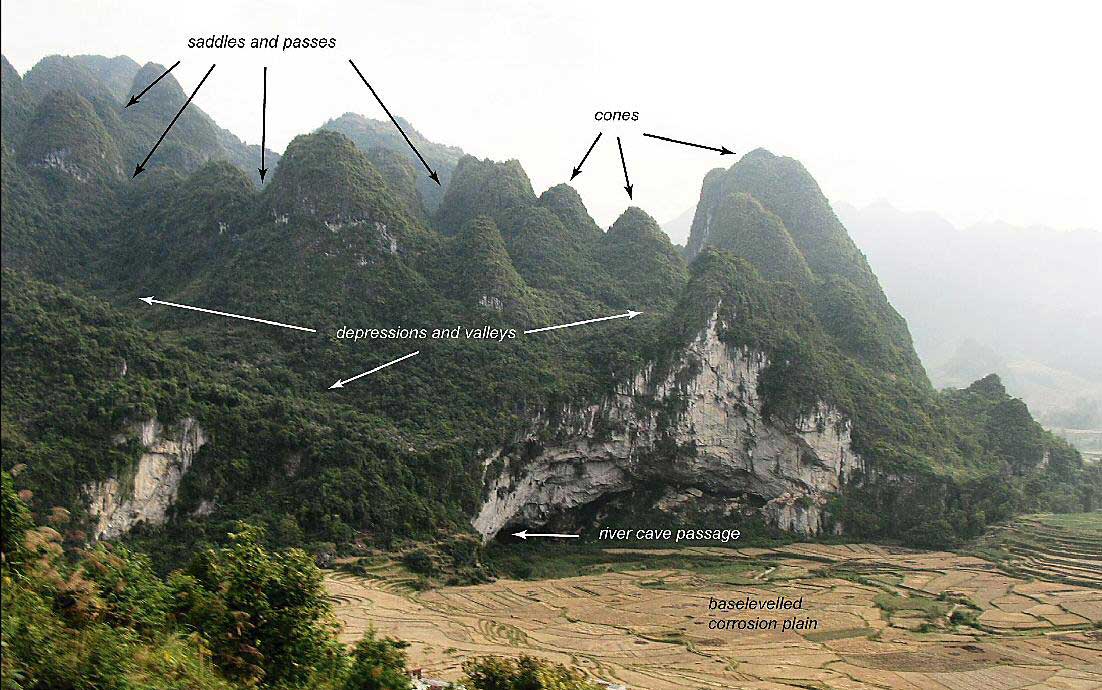
Fig. 6. Fengcong karst with a large underground river beside a bedrock plain in Guangxi.
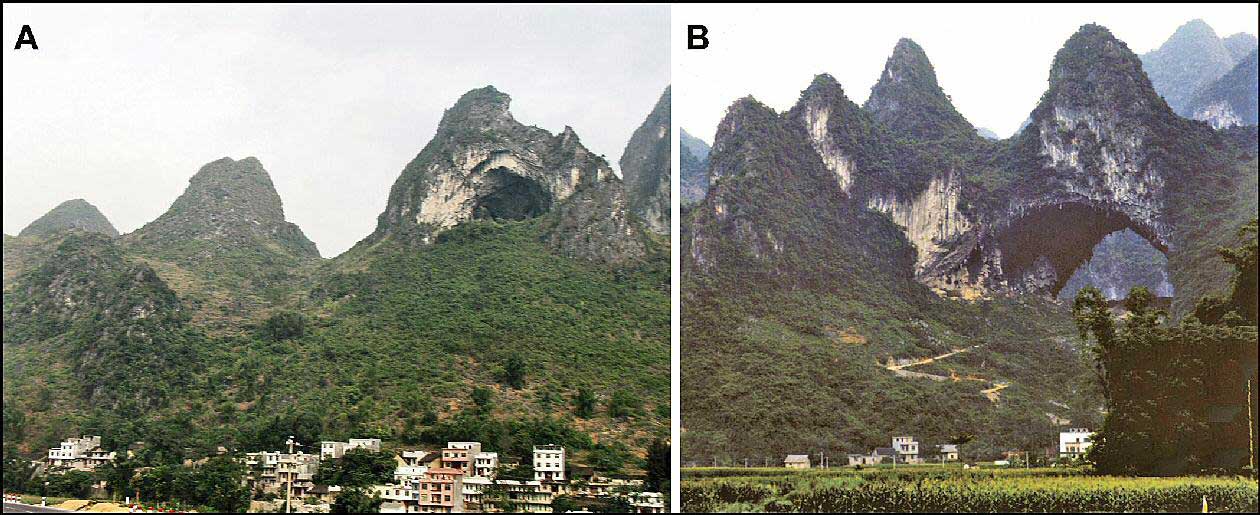
Fig. 7. Truncated remnants of abandoned cave passages in the karst of Guangxi. A : un-roofing of the cave in the hill on the right will dismember the hill and create a new saddle between two smaller hills, but it is not clear if the existing saddle in the centre originated by un-roofing a cave; a remnant of an older saddle lies in the top of the hill, just above the cave entrance, and was formed by destruction of a passage at the higher level, now completely denuded. B : breaching of this dramatic karst bridge will complete the formation of a surface valley, an obvious result of the un-roofing of a large cave passage.
While not completely rejecting other possibilities, it appears that the saddles and passes between cones could be relicts of unroofed cave passages. Their plan pattern and altitude distribution seem to generally conform to an imaginable pattern of mature branch-work cave systems that existed on higher levels, since removed by denudation, though there is scope for specifically designed morphometric analysis to demonstrate this more soundly. In most cases, cross sections and the relative arrangement of the saddles fits to this explanation much better than to subaerial fluvial origins. Some of the cross-sections suggest that they are well preserved remnants of passage profiles (Fig.8), especially where they include hanging walls (Fig.9).
Traditional decorative arts in southern China can be very instructive for karst geomorphologists. Karst landscapes are depicted in artwork in many ways and techniques, and some essential features of landscapes are often captured and represented there with great expressive power (Fig. 10).

Fig. 8. Saddles and passes in the fenglin karst south of Guilin. Their shapes and positions in the topography suggest that these forms may be remnants of almost completely destroyed cave morphologies. When eventually unroofed, a fossil cave in a hill on the right of the photo B will create a new saddle that further dismembers the hill.
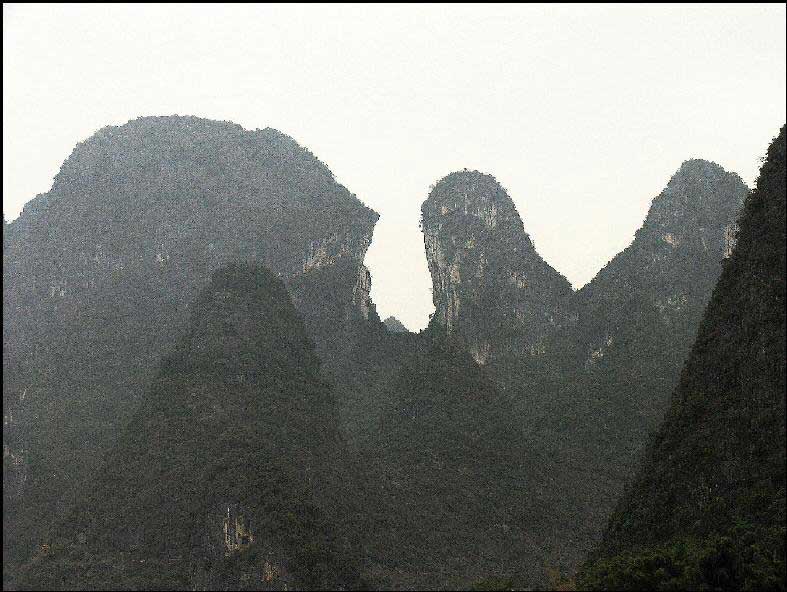
Fig. 9. Fengcong karst in Guangxi: a saddle in the centre, with hanging walls, is a perfect illustration of its origin by un-roofing of a cave passage.
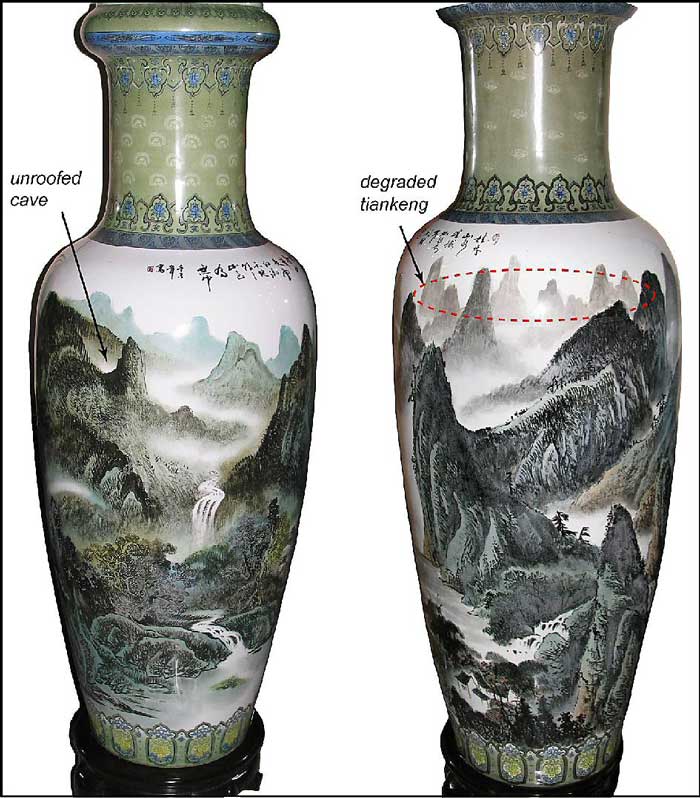
Fig. 10. Chinese vases, depicting fengcong and fenglin karst. Fragments of unroofed passages and degraded tiankengs can be recognised in these landscapes.
Conclusions
A morphogenetic approach is suggested to define tiankeng as a typological category. Tiankengs are giant collapse dolines formed over large river caves, with continuous precipitous perimeter and a diameter-to-depth ratio between 0.5 and 2.0. The term bears an evolutionary meaning, referring to the youthful stage of collapse doline development. Both the large size and the association with large underground rivers tie tiankengs largely to humid tropical environments. This criterion also separates tiankengs from other types of giant collapse features, such as caprock collapses over evaporates or large collapses over hydrothermal cavities.
It is suggested that cave un-roofing through surface collapse may be a large-scale mechanism that plays a significant, probably major, role in the formation of fengcong and fenglin karst terrains. It is probably the major mechanism of origin of large depressions (most of which evolved from tiankengs), gorges and valleys, though other geomorphic processes certainly contribute to shaping and maturation of the landscapes and eventually obscure any origins as unroofed caves. Many saddles between hills and towers in fengcong and fenglin karst may owe their origin to cave un-roofing. This view of the important role of cave un-roofing in tropical karst morphogenesis is strongly supported by multiple evidence from various relicts of former caves integrated into the karst topography and recognizable even in mature landscapes.
Acknowledgement of the important and large-scale role of cave un-roofing in the formation of fengcong and fenglin karst opens new possibilities for morphometric analysis of such terrains and for reconstruction of their geomorphic evolution.
Acknowledgements
Sincere thanks are due to Prof. Zhu Xuewen and his colleagues for organising the China Tiankeng Investigation Project, with one of the most impressive and thought-provoking field trips ever attended by the writer. The roles of Tony Waltham and Andy Eavis in the organization of the project and in providing the possibility to join are also appreciated.
References
- Day, M, 2004. Cone karst. 241-243 in Gunn, J (ed) Encyclopedia of Caves and Karst Science, Fitzroy Dearborn: New York.
- Ford, D C. and Williams, P W, 1989. Karst Geomorphology and Hydrology. Unwin Human: London, 601pp.
- Jennings, J N, 1971. Karst. MIT Press: Cambridge MA, 252pp.
- Mihevc, A, 1996. The cave Brezstropa jama near Povir (in Slovene, English abstract). Nase jame, 38, 65-75.
- Mihevc, A, Slabe, T and Šebela, S, 1998. Denuded caves - an inherited element in the karst morphology; the case from Kras. Acta Carsologica, 27, 165-174.


